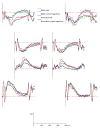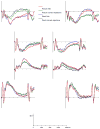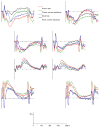The worth of pictures: using high density event-related potentials to understand the memorial power of pictures and the dynamics of recognition memory
- PMID: 17207639
- PMCID: PMC1852523
- DOI: 10.1016/j.neuroimage.2006.11.023
The worth of pictures: using high density event-related potentials to understand the memorial power of pictures and the dynamics of recognition memory
Abstract
To understand the neural correlates of the memorial power of pictures, pictures and words were systematically varied at study and test within subjects, and high-density event-related potentials (ERPs) were recorded at retrieval. Using both conventional and novel methods, the results were presented as ERP waveforms, 50 ms scalp topographies, and video clips, and analyzed using t-statistic topographic maps and nonparametric p-value maps. The authors found that a parietally-based ERP component was enhanced when pictures were presented at study or test, compared to when words were presented. An early frontally-based component was enhanced when words were presented at study compared to pictures. From these data the authors speculate that the memorial power of pictures is related to the ability of pictures to enhance recollection. Familiarity, by contrast, was enhanced when words were presented at study compared to pictures. From these results and the dynamic view of memory afforded by viewing the data as video clips, the authors propose an ERP model of recognition memory.
Figures









References
-
- Achim AM, Lepage M. Neural correlates of memory for items and for associations: An event-related functional magnetic resonance imaging study. J Cogn Neurosci. 2005;17:652–667. - PubMed
-
- Allan K, Wilding EL, Rugg MD. Electrophysiological evidence for dissociable processes contributing to recollection. Acta Psychol (Amst) 1998;98:231–252. - PubMed
-
- Azizian A, Watson TD, Parvaz MA, Squires NK. Time course of processes underlying picture and word evaluation: An event-related potential approach. Brain Topography. 2006;18:213–222. - PubMed
-
- Baddeley AD. In: Working Memory. The Cognitive Neurosciences. Gazzaniga MS, editor. Cambridge, MA: MIT Press; 1995. pp. 755–764.
Publication types
MeSH terms
Grants and funding
LinkOut - more resources
Full Text Sources
Medical

